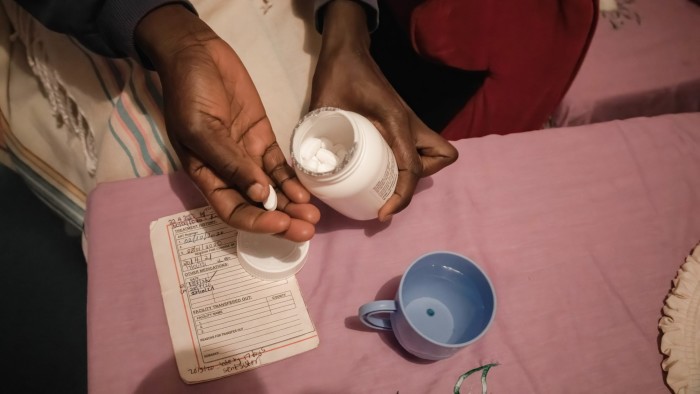Unlock the Editor’s Digest for free
Roula Khalaf, Editor of the FT, selects her favourite stories in this weekly newsletter.
Global rates of HIV infections and deaths related to the virus have dropped sharply but must fall faster to meet a UN target to end Aids as a public health threat by 2030, research has found.
New HIV infection rates in sub-Saharan African countries have plunged more than half since their 1995 peak, but risen steeply in central Europe, eastern Europe and central Asia, the international survey said.
The study published in The Lancet HIV on Monday highlights how drugs and methods of prevention have damped but not yet defeated a pandemic that has killed more than 40mn people since 1980.
New HIV infections fell almost 22 per cent globally to 1.65mn and HIV-related deaths decreased nearly 40 per cent to 718,000 between 2010 and 2021, according to the survey of 204 nations and territories by the US-based Institute for Health Metrics and Evaluation.
This marks significant progress but the trend will come up short of the UN ambition, which includes an interim goal next year of cutting new infections to below 370,000 and deaths to fewer than 250,000.
HIV, the human immunodeficiency virus, leads to the potentially fatal acquired immunodeficiency syndrome (Aids) at advanced stages of infection.
“The world has made remarkable global progress to significantly reduce the number of new HIV infections and lives lost to the disease, yet there are remaining challenges to overcome,” said Dr Hmwe Kyu, IHME associate professor and study author. “More than a million people acquire a new HIV infection each year and, of the 40mn people living with HIV, a quarter are not receiving treatment,” she added.
The big reduction has been driven by a 60 per cent fall between 1995 and 2021 in sub-Saharan African countries in the likelihood of HIV infection over a lifetime, the study says. The risk fell from its mid-90s peak of 21.8 per cent to 8.7 per cent.
The five nations estimated last year by the UNAids agency to have achieved its targets for HIV diagnosis, drug treatment and suppression are all in sub-Saharan Africa — Botswana, Eswatini, Rwanda, Tanzania and Zimbabwe.
But the gains in Africa have been partially offset by a sharp rise in the lifetime risk of acquiring HIV in central Europe, eastern Europe and central Asia, reaching 2.8 per cent in 2021. The prevalence of people living with HIV but without suppression of the virus in those regions more than doubled between 2003 and 2021.
Incidence of HIV and mortality linked to it have also increased in north Africa and the Middle East. The number of people living with HIV globally is forecast to peak at 44.4mn in 2039.
The Lancet study used a range of data sources, including HIV programmes reported to UNAids, household surveys and country-level case reports.
Anti-retroviral drug therapies for HIV, which stop the virus reproducing, are highly effective and are used to prevent infection via so-called pre-exposure prophylaxis (PrEP) as well as in treatment.
The fight against HIV has been further boosted by initiatives such as the US President’s Emergency Plan For Aids Relief (Pepfar), which has funded work in more than 50 countries.
“The global community must make sustained and substantive efforts to sharpen the focus on prevention, optimise access to antiretroviral therapy, and make HIV testing widely available to achieve prompt diagnosis and linkage to care,” said Dr Kyu.
Political commitments to tackling HIV/Aids had sometimes been undermined by “discriminatory attitudes, stigma, punitive laws and physical violence” that had prevented people from accessing needed prevention and treatment services, the Lancet study said.
Pepfar and other public health efforts should be strengthened, it argued.
Read the full article here

